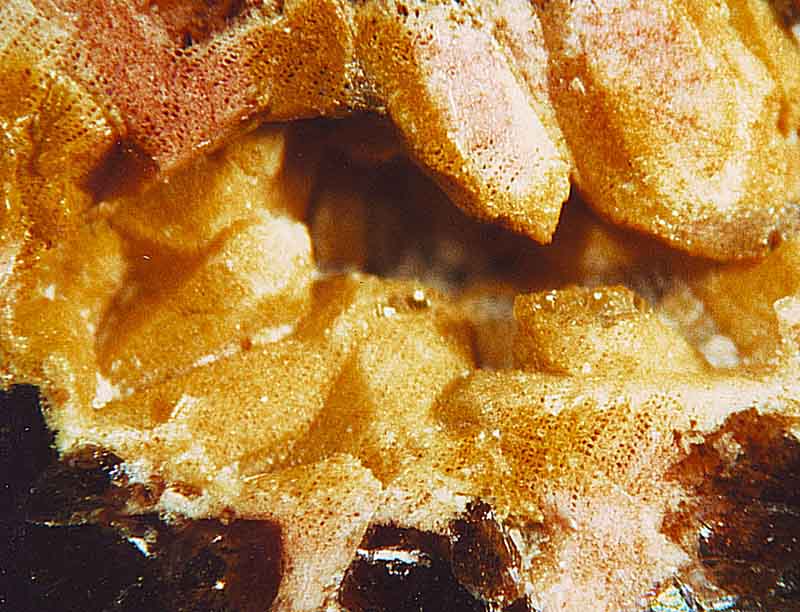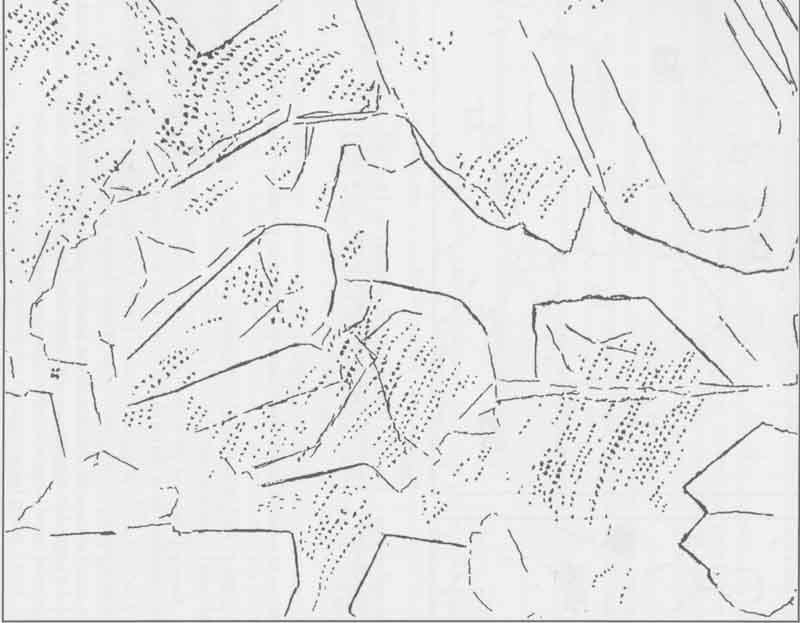"Wood crystals"
Part 2
 As mentioned in a previous
contribution, the
tissue structure of wood had apparently never
been seen before preserved within
quartz crystals, which is surprising as the phenomenon
does not seem to be rare [1,2,3] and various other inclusions in quartz
had been thoroughly investigated before [4].
There is more than one reason why the wood in quartz could have escaped
notice. Inclusions of wood debris which look like dirt as in [2],
Fig.12, would not arouse the attention of mineralogists. Owing to the
transparency of chalcedony and quartz, silicified wood has got a dark
aspect so that eventually present dark cell walls in quartz grains are
easily overlooked.
As mentioned in a previous
contribution, the
tissue structure of wood had apparently never
been seen before preserved within
quartz crystals, which is surprising as the phenomenon
does not seem to be rare [1,2,3] and various other inclusions in quartz
had been thoroughly investigated before [4].
There is more than one reason why the wood in quartz could have escaped
notice. Inclusions of wood debris which look like dirt as in [2],
Fig.12, would not arouse the attention of mineralogists. Owing to the
transparency of chalcedony and quartz, silicified wood has got a dark
aspect so that eventually present dark cell walls in quartz grains are
easily overlooked.
Quite unexpected and largely unexplained is the appearance of the
sample considered here, a small part of which,
width 4.5mm, is shown here. The sample as
a whole consists of silicified wood of dark aspect
as seen below in the image. As an uncommon feature, the apparently dark
quartz
crystals had been growing into the wood, thereby more or less deforming
the wood ahead of them.
What happened next is highly peculiar. Apparently some region of the
wood which had not yet turned into chalcedony or quartz of dark aspect
became white with a slight pink hue, for reasons unknown. (The
pale pinkish white is seen on cut faces, except above left, where a cut
face is darker. Free crystal faces have got a dull yellow stain.)
Closer
inspection reveals that the white aspect is
restricted to the cell walls and possibly
to a deposit on them while most of the cell lumen is clear and
thus appears as a dark spot in cross-section. (See drawing below.)

The crystal above left, partially
seen with its tip, seems to have pushed the tissue aside while growing
downward,
then grown right through the bleached wood later, judging from the
angular
shape below whose angle fits to that of the dark crystal tip above.
More crystals had grown
through the white wood preserving its tissue structure inside. Wood
not reached by the growing crystals did not become preserved and thus
vanished, leaving an empty space between the crystal tops.
The present sample is remarkable for the fact that the
crystals seem to have grown effortless through the bleached wood.
Comparison with
other wood-in-quartz phenomena as seen in Fossil
Wood News 1
is not helpful here as it only shows that the aspects differ greatly.
So it appears that there will be no
easy explanation for these observations. It would be of interest to
know, for example, why two different crystal
growth modes enclosing wood tissue could coexist in one sample. (Fig.2
in Part 1 and this image have been taken from two halves of one
sample.)
Since various wood-in-quartz
phenomena have been observed repeatedly on own
samples but never thoroughly investigated, they may become rewarding
subjects of research.
H.-J.
Weiss 2018
[1] H.-J.
Weiss:
Beobachtungen an Kieselhölzern des Kyffhäuser Gebirges.
Veröff.
Mus. Naturk. Chemnitz 21(1998), 37-48.
[2] H.-J.
Weiss, R. Noll: "Holzkristalle".
Veröff. Mus. Naturk. Chemnitz 22(1999), 57-64.
[3] H.
Huhle: Holz
im Quarz. Veröff. Mus. Naturk. Chemnitz 27(2004), 123-24.
[4] R. Rykart:
Quarz-Monographie, Ott Verlag Thun, 1989
|

|
 30 30 |

 30
30 As mentioned in a previous
contribution, the
tissue structure of wood had apparently never
been seen before preserved within
quartz crystals, which is surprising as the phenomenon
does not seem to be rare [1,2,3] and various other inclusions in quartz
had been thoroughly investigated before [4].
There is more than one reason why the wood in quartz could have escaped
notice. Inclusions of wood debris which look like dirt as in [2],
Fig.12, would not arouse the attention of mineralogists. Owing to the
transparency of chalcedony and quartz, silicified wood has got a dark
aspect so that eventually present dark cell walls in quartz grains are
easily overlooked.
As mentioned in a previous
contribution, the
tissue structure of wood had apparently never
been seen before preserved within
quartz crystals, which is surprising as the phenomenon
does not seem to be rare [1,2,3] and various other inclusions in quartz
had been thoroughly investigated before [4].
There is more than one reason why the wood in quartz could have escaped
notice. Inclusions of wood debris which look like dirt as in [2],
Fig.12, would not arouse the attention of mineralogists. Owing to the
transparency of chalcedony and quartz, silicified wood has got a dark
aspect so that eventually present dark cell walls in quartz grains are
easily overlooked.

 30
30